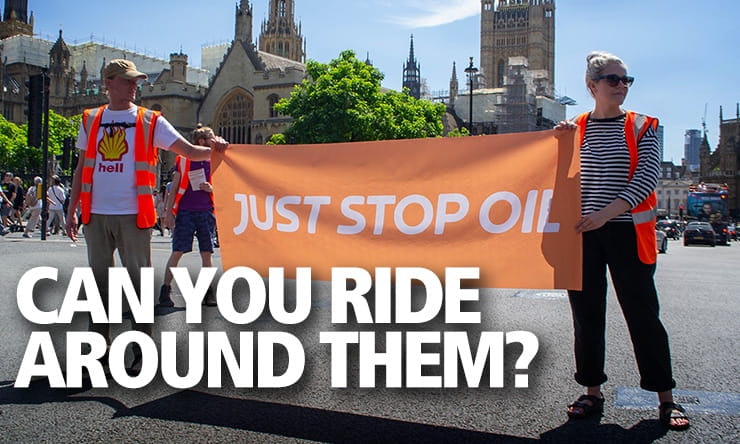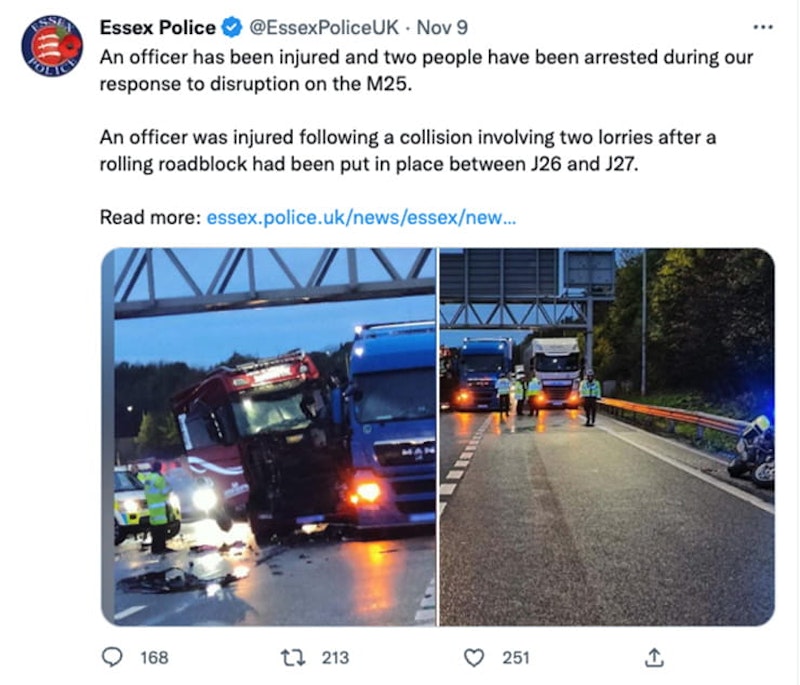Can I ride or drive around protestors blocking roads?
By Dave Yorke
Bike Social contributor and video presenter who swapped police helicopters for something a little more exciting, and landed on a police bike
10.11.2022
With the recent upsurge in protestors blocking city roads, can you legally ride around – or through them – on your motorcycle?
One car driver, Sherilyn Speid, was convicted of dangerous driving after she pushed protestors with her car during a protest. She pleaded guilty to the charge and was banned from driving for a year. She also received a 12-month community order (including 20 days rehabilitation activity) and was ordered to pay £240 of costs, fines, and victim surcharges.
In that case, the driver was in a car that was physically too big to get through a gap, but motorcycles are much smaller, so can we use our manoeuvrability to get through a gap that a car wouldn’t?
Well, it’s worth pointing out that in law the term ‘driving’ also covers riding, so any penalties for car drivers are also available for motorcycle and scooter riders.
Can I ride my motorcycle around protestors by mounting the pavement?
In a nutshell, no. You can only ride a motorcycle on a pavement if you are doing so to access a property or place where you are legally allowed to be. And even then, its only for a maximum of 15 yards, which is around 13.7 metres or 45 feet.
It’s all covered under section 34 of the Road Traffic Act and we get an easy reminder of it at Rule 145 of the Highway Code where it says “You MUST NOT drive on or over a pavement, footpath or bridleway except to gain lawful access to property, or in the case of an emergency”.
That the Highway Code states ‘must not’, rather than ‘should not’ signifies it’s backed up by law. Section 34 of the Road Traffic Act in this case.
Can I push my motorcycle through a small gap in protestors?
This where we come back to definition of driving, which for clarity’s sake also covers riding. There is case law that defines driving however, and in the case of motorcycles it can be arguable as to what actually constitutes driving.
Section 192 of the Road Traffic Act states in a very basic way that a driver is someone who steers the vehicle as well as any other person ‘engaged in driving’.
In R v MacDonagh in 1974 at the court of appeal it was held that MacDonagh was not driving when, as a disqualified driver having been told to move his car by a police officer, he pushed his car with his shoulder against the pillar while having both feet on the ground.
The court of appeal stated that the essence of driving was the use of the driver’s controls in order to direct the movement of the car, but additionally the word driving must be given its ordinary meaning.
There are cases where it was held that sitting astride a motorcycle, paddling it along and trying to start it was regarded as driving, even though the bike was faulty and wouldn’t start.
In another case, McKeon v Ellis, it was held that pushing a motorcycle with the ignition and lights on was driving, but only if the defendant was wearing motorcycle leathers and a helmet.
Any clearer? Bearing in mind that a protestor’s intent is to stop or delay your journey, they won’t move and are happy for you to get in trouble then I wouldn’t want to be the one waiting on a decision at court to see if I was regarded as driving or not, especially if one of the protestors was hurt, however slightly.
Can I get past protestors on a motorway?
If you are on a city street and see a protest, then at least on a motorbike you can always use our highly agile lifestyle choice to circumnavigate a blockage, whereas car and van drivers might be stuck. On a motorway it’s a different matter and the best we’re going to manage is to filter to the front of the queue so at least we’ll be in the best position for the getaway once the road reopens.
If a motorways is blocked, can I go back to the last junction?
You can only go back on a motorway if the police or highways agency instigate a plan to do so. It’s called ‘rearward relief’ and they will get the blocked traffic running in reverse on the carriageway, but you should only do this if told to. Don’t be tempted to go back along the hard shoulder, even if it’s only a matter of yards.
Image from The Highway Code
Are the red Xs on motorway gantries legally enforceable?
You mustn’t go past a red X in the lane below it, or the one marked on a roadside sign. There might not even be any police present, there simply being a full row of Red X’s above all lanes, but you’ve still got to stop as there could be anyone and anything in the road ahead.
Rule 258 of the Highway Code again states it’s a MUST, not a SHOULD, telling us it’s backed-up by law. Aside from the penalties for going beyond a Red X – a £100 fine and three points on your licence – it’s just not worth it. Everyone working on the motorway wants to go home at the end of their shift, and it’s a dangerous place to work at the best of times.
Do I just have to wait if protestors are blocking the motorway?
Assistant Commissioner Matt Twist said people should "call us, and we will deal."
Mr Twist said he "completely understood their frustration," but people taking matters into their own hands could hamper prosecutions.
This is because the police must "work within the clear legal framework and secure evidence for the offence of highway obstruction", he explained.
"Showing clearly that there is an obstruction, that it is deliberate, that it is unlawful, and finally within the context of protest, that it is unreasonable in all of the circumstances", he added.
"Without this evidence, any prosecution may fail and the offenders will not be held to account for their actions."
He said the force is "determined to bring to justice all of those who have caused significant and unreasonable disruption to London, or caused damage to buildings, property or valuables"
For my view, I used to tell untrained cops not to intervene when they saw an off-road bike goading them on the road, but to simply call it in and see if there was a trained and authorised response available. At the very least it would go on the call log, and we could formulate plans for future events. At best it stopped that untrained cop making a decision that might be with them for months if they ended up being investigated.
It’s pretty much like that here; the police are rightly asking the public not to intervene. Not because they want to give protestors an easy ride, but because they don’t want the public being put in untenable positions.

